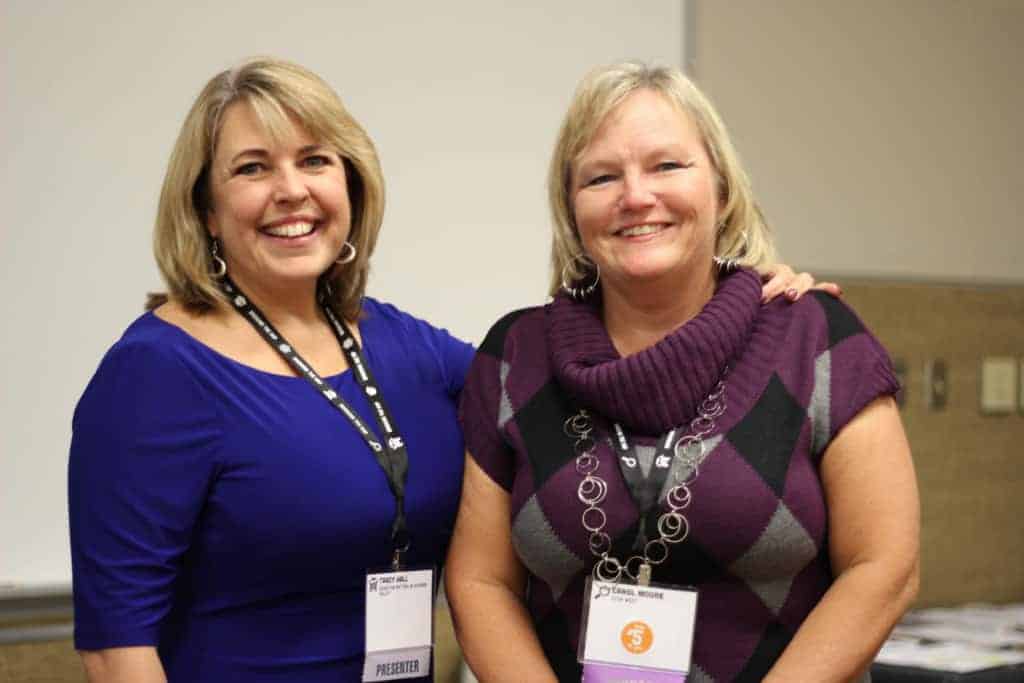

Last week, STEM leaders and educators gathered in Raleigh to “share ideas and resources” in topics ranging from personalized learning to biomedical technology to using drones as part of the seventh annual Bridging the Gap Conference.
Below are recaps of some of the sessions I attended.
Bringing real world collaborations to the classroom


“What percent of the top 50 jobs require STEM knowledge?” Jill Barclay asked attendees, sharing a slide of the US News and World Report’s article of the top 50 jobs in 2017.
“100 percent,” she said. “We are keeping that in mind as we grow our elementary students.”
But how do teachers connect their students to these STEM careers from the classroom? Jill Barclay and Emily Warnke of Charlotte Mecklenburg Schools focused their presentation on “the importance of building partnerships between K-12 education and STEM industries, how to get STEM industries involved at the elementary level, and what STEM companies are able to offer elementary educators.”
And they had one fairly simple answer on exposing STEM industry to elementary students: invite guest speakers to give students direct access to industry role models.
“Just getting the real world in your classroom is important,” said Warnke of her endeavor to invite STEM professionals into the classroom. “It ranged from my son’s orthodontist, to the veterinarian, to engineers in different professions — both retired and those still working in their profession — county extension agents, the health department, the city water department.”
And Warnke pointed to one important local STEM partner: community college.
“We have had a high emphasis on college and career ready, and there are a ton of STEM jobs that don’t require a four-year degree to be successful,” Warnke said. “The advanced manufacturing industry is hurting for skilled workers. They’re not looking for college grads.”
Part of the process for teachers is simply knowing these resources exist in their communities.
“We need to be sure we know what’s out there,” said Barclay. “Because we are in our little boxes all day long.”
So CMS started staff field trips for teachers. Last year, teachers went to four different manufacturers and a software company.
“We got to see what it was like to work outside of the school basically,” said Barclay. “Lots of great things have happened over the past two years at our school just because we opened up our minds to what it could look like.”
A different set of eyes: Instructional practices to address equity issues in the STEM classroom


“The majority of teachers in North Carolina — in the United States — are white females,” said high school teacher and presenter Michelle Ellis. “That is not your student.”
With a presentation focused on implementing culturally-relevant teaching to “provide opportunities for all STEM learners,” Ellis wasn’t afraid to make the attendees uncomfortable. In one activity, participants were asked to write identifying attributes about themselves: age, ethnicity, number of children, religion, among others. Then they were to turn to the person next to them and guess those same factors without asking their partner any questions. It was simply gathering information about the other perceived just by looking at them.
“We ourselves as teachers, we try to fit things into a file cabinet,” Ellis said, explaining that this includes people.
“We have to have a different perspective,” she said. “A different set of eyes that we have to look through.”
This perspective, informed by Dr. Gloria Ladson-Billings’ culturally-relevant teaching, ultimately allows teachers to engage their students, be able to better determine what is behind student behaviors, and shift the blame away from individual students.
“We should stop putting it on the kids,” Ellis said. “We literally have to meet them where they’re at … See the whole child,” she said.
Connecting students to STEM careers through EXTREME STEM tours


Carol Moore of STEM West and Tracy Hall of Education Matters in Catawba Valley deal with students at a particularly difficult stage: eighth grade.
“Eighth graders aren’t excited by much,” said Moore. “For them to say anonymously that they liked something, that’s kudos from an eighth grader.”
With 30 years of middle school science education experience, Moore would know. But she did find something that clicked with these rising high schoolers — EXTREME STEM tours.
“It’s extreme for a lot of reasons,” Hall said. At this point, the program has involved over 60 local businesses (including Duke Energy, Corning Cable Systems, Vanguard Furniture, and Charlotte Charter Jet) and over 12,800 eighth graders since 2009.
The tours are also uniquely partnered with Catawba Valley Community College and Appalachian State’s NC Center for Engineer Technologies, connecting post-secondary training to the STEM industry.
But were these tours really getting students interested in STEM careers in middle school?
In a survey of over 1,000 EXTREME STEM tour participants — five years after the tour, when they were getting ready to graduate high school — 200 graduating seniors remembered STEM tours and 200 students said that the one-day event influenced what courses they took in high school.
“They would say, ‘I understand why I need to do better in math class,'” said Moore. “We were getting those results.”
According to Hall, it’s because students are “right there, immersed in the environment.” They are seeing jobs in action and also learning about skills and salaries.
And it turns out, students aren’t the only ones getting something out of the tours.
“I’ve got tons of testimonies from teachers,” Hall said, explaining that teachers said the tours were bringing relevancy to what was taught in the classroom. As for the businesses — “At this point businesses call me,” Hall said.


